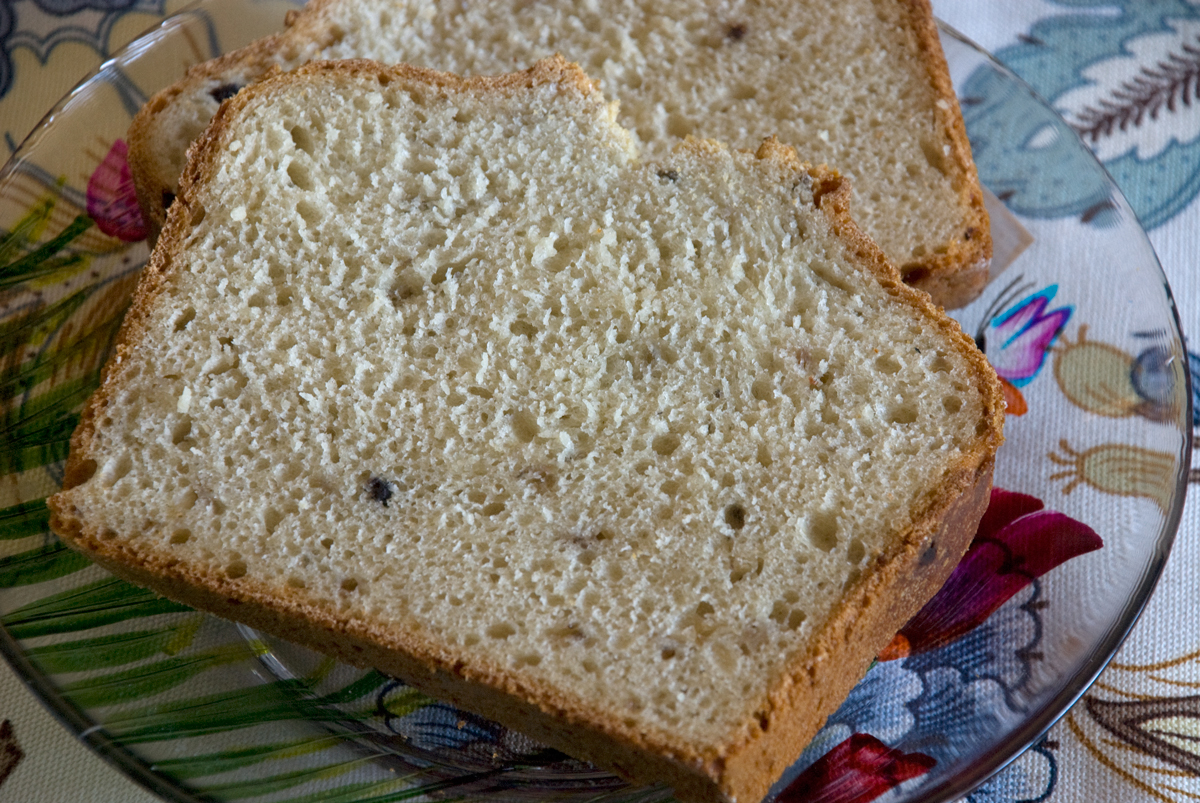
Durum Sourdough English Muffin Bread with Cheese
 My wife is not a big fan of my multi-grain breads and I'm always getting on her for not trying more of my breads. For this reason I agreed to make her an English Muffin bread, which was simple and plain. Well you know by now if you follow my posts that I don't know the meaning of the word simple so here is as close as I could bring myself to make a simple English Muffin style bread.
My wife is not a big fan of my multi-grain breads and I'm always getting on her for not trying more of my breads. For this reason I agreed to make her an English Muffin bread, which was simple and plain. Well you know by now if you follow my posts that I don't know the meaning of the word simple so here is as close as I could bring myself to make a simple English Muffin style bread.
I used a similar recipe that I have used for my last batch of English Muffin and baked it in a loaf pan and the results were better than I expected. It tastes like an English Muffin but you can taste the Durum flour I used in the starter and a hint of the cheese I added in. I used a blueberry cheddar cheese to make it interesting but in hindsight I should have added more than I did to really get the flavor.
The bread came out with a nice English Muffin open crumb and makes great toast.
English Muffin Bread Main Dough
165 grams Durum Starter (you can use your regular Sourdough starter at 65% hydration instead if desired. I had this left over from one of my previous bakes)
620 grams European Style Flour (KAF or use Bread Flour with a little Whole Wheat)
300 grams Greek Plain Yogurt (I used Fage 2%)
235 grams Water (85-90 degrees F.)
50 grams Cheese (I used grated Blueberry Cheddar. Add in final mix)
26 grams Sugar
10 grams Salt
12 grams Baking Soda
Semolina or Cornmeal for Dusting
Directions
Mix flour, starter, water and yogurt in your mixing bowl and mix for 1-2 minutes to combine. (Note: in my English Muffin recipe I did not add the water until the second day, but I forgot and mixed it up first and it didn't seem to hurt anything).
Cover the bowl and let it sit out at room temperature overnight or for at least 9-10 hours.
The next morning add the rest of the ingredients and mix for a minute. Knead the dough either with your mixer or by hand for around 4 minutes, adding additional flour if necessary. Next place the dough in a lightly greased bowl and let it rest covered for 1 hour at room temperature about 70 degrees F. After the rest form it into a loaf shape and place it in a greased bread pan and let it rise covered with a moist towel or greased plastic wrap for another hour until the dough rises about even with the top of your baking pan which in my case was about a 50% rise. This bread will get a huge lift in the oven so don't worry if it doesn't rise too much while resting.
Pre-heat the oven to 350 degrees F. and when ready to bake add your steam per your normal method and bake for around 45 minutes to an hour until the internal temperature reaches 200 degrees.
Let the bread rest on a rack for about 2 hours and then enjoy!




Comments
Hi Ian,
I have seen recipes in Bernard Clayton's bread book that include baking soda in the ingredients despite the use of IY. Never understood that but here you have included it in your bread so I am hoping you know why it is added along with the leaven since both are leavenings.....What does it add to this loaf that just leaven wouldn't?
This does indeed look like a nice simple bread. Must have been very moist too with the yogurt. I have a yogurt yeast loaf that I like baking that Akiko posted a couple of years ago. Pretty much the same method you used of spiking yogurt and flour with some sd. Always smells heavenly when it has finished fermenting.
Thanks for the post.
Take Care,
Janet
Hi Janet, thanks for the comment. I actually do not really know why the baking soda would be needed except that when using this method for English Muffins it seems to add an extra lift for the muffins when cooking them in the skillet. I suppose since I made this into a bread instead I could have left it out but I saw other recipes using yeast where it was still left in. Maybe someone smarter than us can provide us the answer.
It did however provide amazing oven spring so I would leave it in for the next time.
Regards,
Ian
Hi Ian,
Thanks for the response. My method: "If it works, don't mess with it!" Your method worked so something made a difference. I will have to do some experimenting of my own now and see what I get.
Take Care,
Janet
Hey Ian, Lovely bread. I hope your wife appreciates you. -Varda
Thanks Varda....us husbands never feel appreciated enough :).
You can ask her yourself in a few weeks..
Ian
Very nice photos, Ian, and of course a very nice loaf. (Breads with cheeses is a thumbs up from me---well, in most cases.) The crumb looks soft and tender, thanks to the cheese and yogurt. And I wonder... how much of an impact does the baking soda has on the bread? I'm guessing it provides substantial lift.
Keep up the great bakes,
Zita
Thanks Zita.
Appreciate your kind words.
I would say that the baking powder really gave it a huge lift in the oven. When I put the pan in the oven the dough was not even up to the top of the pan and as you see it grew exponentially.
Look forward to reading about your next adventure. Hope you found some nicer critics and test tasters!
Ian
My husband is a chemist so I asked him what you did. He said you had a simple chemical reaction. Acid of your yogurt reacted with the base of the baking soda. This is the same reaction one gets when one makes naan. Great looking bread.
On another note I made 2 doz of your buns yesterday..also 2 doz bagels ( 100% sourdough from Wild Yeast's blog) and 3 Norwich Sourdough boules. A double batch of granola was the dessert :) Your buns continue to be a hit. Everyone who tries them is so impressed and thinks they contain the makings from my challah recipe. This batch worked well in my KA even with it a double batch. I used only my semi firm kefir and no sourcream or ricotta etc. I used part buttermilk and part 1/2 and 1/2 with some water to thin for all of the milk. Made a pretty loose dough. I turned up the KA and let it slap the dough around as one does ciabatta. Wow...the gluten developed before my eyes. What a lovely and huge growing mass I had. It pushed the top off of the container in the fridge overnight LOL ! I again shaped while chilled. So easy and let rise about 1 hr while the boules were baking. I spray with a hand mister as I have a convection Miele that has a fan that blows all the time when oven on. It worked great. Got beautiful expansion and the crumb is outstanding. Didn't take pics...was so busy. Anyway...I love reading your adventures and look forward to trying the above bread too. c
Thank you so much Trailrunner! So happy my rolls are working out for you and thanks for the feedback on the chemical reaction. That's kind of what I thought, but I'm no chemist :).
Hope you give this one a try.
Regards
Ian
Hi, Ian,
Your bread was on my to-do list for a very long time. Now it served as one of my "Corona-comfort bakes". I used my whole wheat starter, and omitted the cheese (because I like it with jam, too).
The bread turned out great. We just had it for dinner.
I was, also, wondering about the baking soda, but, with all the Greek yogurt, it certainly didn’t hurt, though my starter rose nicely overnight.
Stay safe,
Karin
I'm so glad you gave this oldie but goody a try. I actually made English Muffins last month and wasn't happy with the results. I tinkered with my formula and made it worse instead of better ?. Most recipes for English muffins call for baking soda. It gives it a little extra kick when you bake them up I believe.
I hope you and your family are staying safe. It's always nice to hear from you.
Regards,
Ian